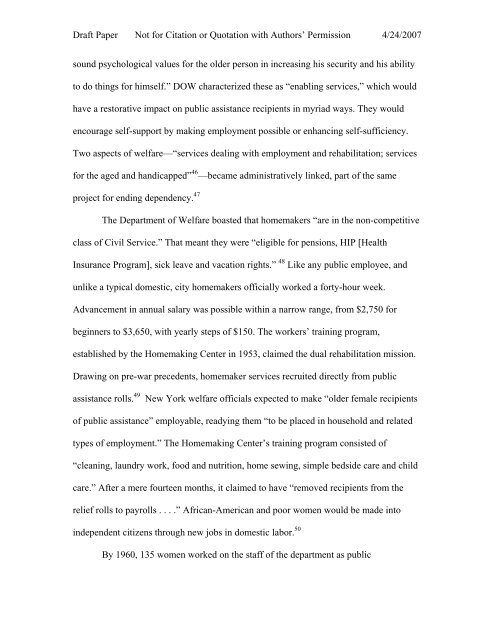Organizing Home Care: - School of Social Service Administration
Organizing Home Care: - School of Social Service Administration
Organizing Home Care: - School of Social Service Administration
You also want an ePaper? Increase the reach of your titles
YUMPU automatically turns print PDFs into web optimized ePapers that Google loves.
Draft Paper Not for Citation or Quotation with Authors’ Permission 4/24/2007<br />
sound psychological values for the older person in increasing his security and his ability<br />
to do things for himself.” DOW characterized these as “enabling services,” which would<br />
have a restorative impact on public assistance recipients in myriad ways. They would<br />
encourage self-support by making employment possible or enhancing self-sufficiency.<br />
Two aspects <strong>of</strong> welfare—“services dealing with employment and rehabilitation; services<br />
for the aged and handicapped” 46 —became administratively linked, part <strong>of</strong> the same<br />
project for ending dependency. 47<br />
The Department <strong>of</strong> Welfare boasted that homemakers “are in the non-competitive<br />
class <strong>of</strong> Civil <strong>Service</strong>.” That meant they were “eligible for pensions, HIP [Health<br />
Insurance Program], sick leave and vacation rights.” 48 Like any public employee, and<br />
unlike a typical domestic, city homemakers <strong>of</strong>ficially worked a forty-hour week.<br />
Advancement in annual salary was possible within a narrow range, from $2,750 for<br />
beginners to $3,650, with yearly steps <strong>of</strong> $150. The workers’ training program,<br />
established by the <strong>Home</strong>making Center in 1953, claimed the dual rehabilitation mission.<br />
Drawing on pre-war precedents, homemaker services recruited directly from public<br />
assistance rolls. 49<br />
New York welfare <strong>of</strong>ficials expected to make “older female recipients<br />
<strong>of</strong> public assistance” employable, readying them “to be placed in household and related<br />
types <strong>of</strong> employment.” The <strong>Home</strong>making Center’s training program consisted <strong>of</strong><br />
“cleaning, laundry work, food and nutrition, home sewing, simple bedside care and child<br />
care.” After a mere fourteen months, it claimed to have “removed recipients from the<br />
relief rolls to payrolls . . . .” African-American and poor women would be made into<br />
independent citizens through new jobs in domestic labor. 50<br />
By 1960, 135 women worked on the staff <strong>of</strong> the department as public
















